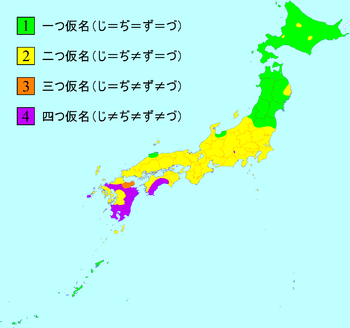Yotsugana

Yotsugana (四つ仮名, literally "four kana") are a set of four specific kana じ, ぢ, ず, づ (Nihon-shiki: zi, di, zu, du) used in the Japanese writing system. They historically represented four distinct voiced morae (syllables) in the Japanese language; however, today, in standard Japanese and the dialects of most Japanese speakers these morae have merged down to two sounds. Most far northern dialects (Tōhoku dialects and Hokkaidō) and far southern dialects (notably Okinawan Japanese) and the Ryukyuan languages (the other Japonic languages) have also mostly merged these down to one sound. However a few dialects, namely around Shikoku and Kyushu in the southwest, have conserved the distinction between three or all four sounds. In the current Tokyo dialect, on which the standard Japanese language is based, only two sounds are distinguished as represented in the Hepburn (ji, ji, zu, zu) and Kunrei (zi, zi, zu, zu) romanization systems; likewise in the widely spoken Kansai dialect.
Modern kana usage
The spelling differences between the four kana were retained well up to the mid-twentieth century, long after the different sounds they represented had merged leaving only two distinct morae in most mainland dialects such as that of Tokyo. Shortly after the end of World War II, the discrepancy between kana usage and pronunciation was rectified as part of a general orthographic reform known as the Gendai Kanazukai, or modern kana orthography. Under the new orthographic rules, only the two kana じ zi and ず zu are to be used, though two notable exceptions exist:
- When a word exhibits sequential voicing, or rendaku, as a result of compounding a second morpheme that would otherwise begin with the kana つ tu or ち ti in isolation (e.g. 神無月 かんなづき, kannaduki, where 月 in isolation is written つき tuki);
- When the kana つ tu or ち ti are repeated and voiced in a word (e.g. 続く つづく, tuduku).
An exception to this spelling unification was permitted for regions that pronounced the four kana as three or four distinct sounds. After a 1986 update to the Gendai Kanazukai, this exception was replaced with a statement that the unified spelling was to be primarily used, while still permitting etymologically correct spellings.
Modern regional variants
The table below shows some of the different realizations and mergers of the Yotsugana characters throughout Japan.
| Variants | ぢ di | じ zi | づ du | ず zu |
|---|---|---|---|---|
| Tokyo (standard) | [d͡ʑi] ~ [ʑi] | [d͡zu͍] ~ [zu͍] | ||
| North Tohoku, Izumo | [d͡ʑi][citation needed] | |||
| South Tohoku | [d͡zu͍] | |||
| Kōchi (Hata, Tosa) | [di] ~ [dᶻi] | [ʑi] | [du͍] ~ [dᶻu͍] | [zu͍] |
| Kagoshima | [d͡ʑi] | [ʑi] | [d͡zu͍] | [zu͍] |
| Okinawa | [d͡ʑi] | |||